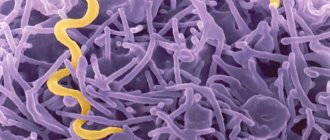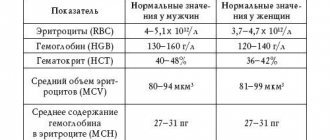How are bacteria different from viruses?
Bacteria are overwhelmingly unicellular microorganisms with an unformed nucleus.
That is, these are real cells that have their own metabolism and reproduce by division. According to the shape of the cells, bacteria can be round in shape - called cocci (staphylococcus, streptococcus, pneumococcus, meningococcus, etc.), they can be rod-shaped (Escherichia coli, pertussis, dysentery, etc.), and other forms of bacteria are less common. Many bacteria that are normally safe for humans and live on their skin, mucous membranes, and intestines can act as pathogens in case of general weakening of the body or impaired immunity.
Unlike bacteria, viruses are parasites that are unable to reproduce outside the cell. They enter the cell and force it to produce copies of the virus. When a cell becomes infected, special defense mechanisms against viruses are activated. Infected cells begin to produce interferon, which comes into contact with neighboring healthy cells and puts them into an antiviral state, and also stimulates the immune system to fight viruses.
Some viruses can remain in the human body throughout life. They go into a latent state and are activated only under certain conditions. These viruses include herpesviruses, papillomaviruses and HIV. In a latent state, the virus cannot be destroyed by either the immune system or medications.
Acute respiratory viral infections (ARVI)
ARVI is a viral disease of the upper respiratory tract transmitted by airborne droplets. Respiratory viral infections are the most common infectious disease.
All ARVIs are characterized by a very short incubation period - from 1 to 5 days. This is the time during which the virus that has entered the body manages to multiply to the point where the first symptoms of the disease begin to appear.
After the incubation period, the prodromal period (prodrome) begins - this is the period of the disease when the virus has already spread throughout the body, and the immune system has not yet had time to react to it. The first symptoms begin to appear: lethargy, moodiness, rhinitis, pharyngitis, a characteristic shine in the eyes.
The next stage is the onset of the disease. ARVI, as a rule, begins acutely - the temperature rises to 38-39 ° C, headache, chills, runny nose, cough, and sore throat may appear. It is advisable to remember when the infection could have occurred, that is, when there was contact with the carrier of the virus, since if no more than five days have passed from this moment until the onset of the disease, then this is an argument in favor of the viral nature of the disease.
Viral infections are usually treated symptomatically, that is, antipyretics, expectorants, etc. Antibiotics do not work on viruses.
The most well-known viral infections are influenza, ARVI, herpes infections, viral hepatitis, HIV infection, measles, rubella, mumps, chicken pox, tick-borne encephalitis, hemorrhagic fevers, polio, etc.
Signs of viral and bacterial infection
One of the main roles is played by the duration of poor health. Typically, a viral disease lasts longer than a bacterial one. The malaise lasts 1-3 days, then the condition stabilizes, but some signs still remain. If symptoms last 7 days or longer and do not go away within a specific time, you need to go to the doctor and consult about antibiotics. A viral illness can turn into sinusitis or increase the risk of otitis media.
Look at the color of the discharge from the mucous membrane when you blow your nose or cough up phlegm. Watery and transparent means the virus is in the body. Dark green discharge means bacteria in the body.
Then examine your throat. Pain is observed with viruses and bacteria. To understand whether you need to take antibiotics, the doctor pays close attention to your throat. Its specific color indicates the presence of bacteria. White spots provoke the appearance of microbes. If the pain is characterized by a runny nose and sneezing, then this also signals a bacteria.
Temperature also plays an important role. If there is a bacteria in the body, it is higher. If the temperature does not subside for 2-3 days, then if the virus is present, it will recover after a couple of days. Normal body temperature is 36.7-37.3 degrees. If specific symptoms occur, you should immediately go to the doctor. Many viruses and bacteria can be eliminated at home. You should consult a doctor if you have the following symptoms:
- Rare urination.
- Labored breathing.
- Feeling unwell for 3-5 days.
- Deterioration of general condition.
Blood picture for viral infections
During viral infections, the white blood cell count usually remains within the reference range or slightly below normal, although a slight increase in the white blood cell count may sometimes be observed. Changes in the leukocyte formula occur due to an increase in the content of lymphocytes and/or monocytes, and accordingly a decrease in the number of neutrophils. ESR may increase slightly, although in severe acute respiratory viral infections the erythrocyte sedimentation rate can be quite high.
How to distinguish a viral infection from a bacterial one using a blood test
A correct diagnosis is the key to successful treatment and quick recovery. Laboratory diagnostic methods can help with this, the main one of which is a general blood test. How to tell if a virus or bacteria is in the body using a blood test. Let's figure it out. A clinical blood test is one of the simplest and most common laboratory tests that allows you to evaluate important indicators of the patient’s health: hemoglobin, erythrocytes (red blood cells), leukocytes (white blood cells), ESR (erythrocyte sedimentation rate). A detailed blood test also evaluates the ratio of different types of leukocytes (leukocyte formula), platelets, hematocrit, etc.

To determine a viral or bacterial infection in a person by blood, you need to know the leukocyte formula, ESR and total number of leukocytes. Leukocytes are the main defenders of the immune system, which is why the deviation of their value in one direction or another can be used to judge the presence of any pathological process in the body. This can be done not only by the doctor, but also by the patient himself. Depending on which pathogenic microorganisms have infected healthy cells, certain changes occur in the structural composition of human blood. By identifying them, you can find out how to properly treat them.
Bacterial infections
Bacterial infections can occur on their own or be associated with a viral infection, since viruses suppress the immune system.
The main difference between bacterial infections and viral ones is the longer incubation period, which ranges from 2 to 14 days. Unlike viral infections, in this case you should pay attention not only to the expected time of contact with the carrier of the infection, but also take into account whether there has been recent stress or hypothermia. Since some bacteria are able to live in the human body for years without manifesting themselves and become more active in the event of a general weakening of the body.
There is often no prodromal period for bacterial infections; for example, an infection can begin as a complication of acute respiratory viral infection. And if viral infections often begin with a general deterioration of the condition, then bacterial infections usually have a clear local manifestation (sore throat, otitis media, sinusitis). The temperature often does not rise above 38 degrees.
Bacterial infections are treated with antibiotics. To prevent possible complications of the disease, it is important to start treatment on time. Using antibiotics without appropriate indications can lead to the formation of resistant bacteria. Therefore, only a doctor should select and prescribe antibiotics correctly.
The most common bacterial infections are sinusitis, otitis, pneumonia or meningitis (although pneumonia and meningitis can also be viral in nature). The most well-known bacterial infections are whooping cough, diphtheria, tetanus, tuberculosis, most intestinal infections, syphilis, gonorrhea, etc.
How to tell if a disease is viral or bacterial
Let's look at the symptoms of viral and bacterial infections. You can understand whether a person has a viral or bacterial disease first of all by the symptoms. General malaise, fever and body aches, profuse lacrimation, sneezing, swelling of the nose and a clear runny nose, which go away on their own after 3-5 days, are usually signs of a viral disease. A viral infection is most often treated symptomatically, or with the help of antiviral or immunomodulatory drugs. The most common viral infections are: ARVI, influenza, measles, rubella, HIV infection, chicken pox, infectious mononucleosis, HPV, herpes virus, etc.
Plaque on the mucous membrane, pain in a certain place, high temperature, unpleasant odor, purulent discharge, daily deterioration of health in the absence of treatment most often indicate a disease of a bacterial nature. A bacterial infection can occur either on its own or as a complication after a viral illness due to weakened immunity. Basically, its symptoms begin with a local lesion (sore throat, nasal discharge, etc.). Diseases caused by bacteria are treated with antibiotics.
To avoid the formation of resistance, it is very important to be treated with a full course and preferably after conducting a sensitivity test (bacterial culture). The most common diseases caused by bacterial infections are: sore throat, sinusitis, bronchitis, otitis media, intestinal infections, cystitis, pyelonephritis, etc. Treating viruses with antibiotics and bacteria with antivirals is fraught with complications. Because antibiotics do not kill viruses, treatment with them leads to an even greater decline in immunity, and antiviral drugs do not affect bacteria, which causes the disease to progress and can lead to serious consequences.
Blood picture for bacterial infections
With bacterial infections, there is usually an increase in the number of white blood cells in the blood, which occurs mainly due to an increase in the number of neutrophils. A so-called shift of the leukocyte formula to the left is observed, that is, the number of band neutrophils increases, and young forms may appear - metamyelocytes (young) and myelocytes. As a result, the relative (percentage) content of lymphocytes may decrease. The ESR (erythrocyte sedimentation rate) is usually quite high.
Automatic interpretation of blood test











